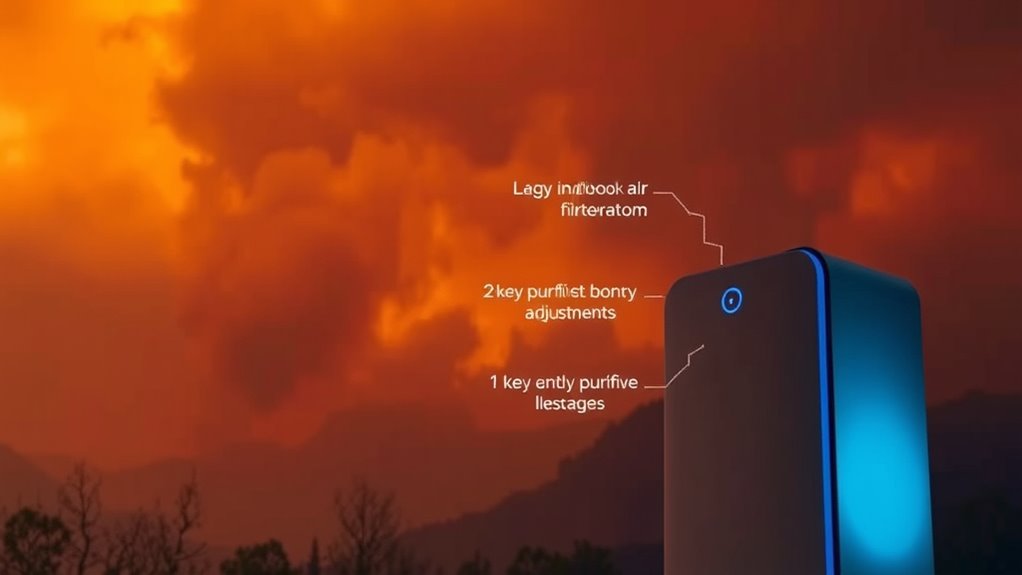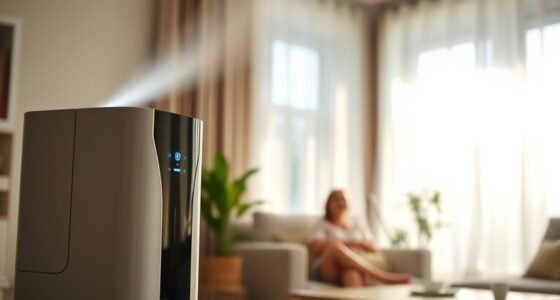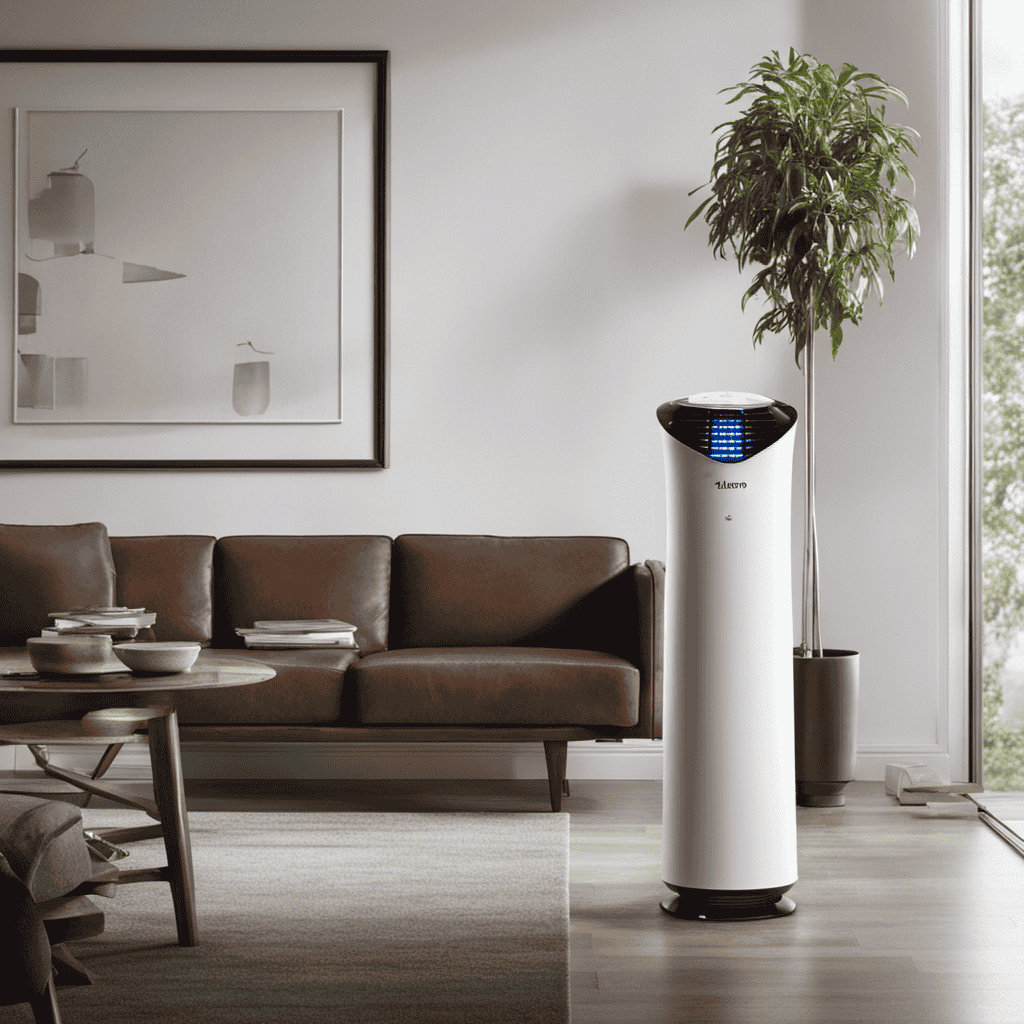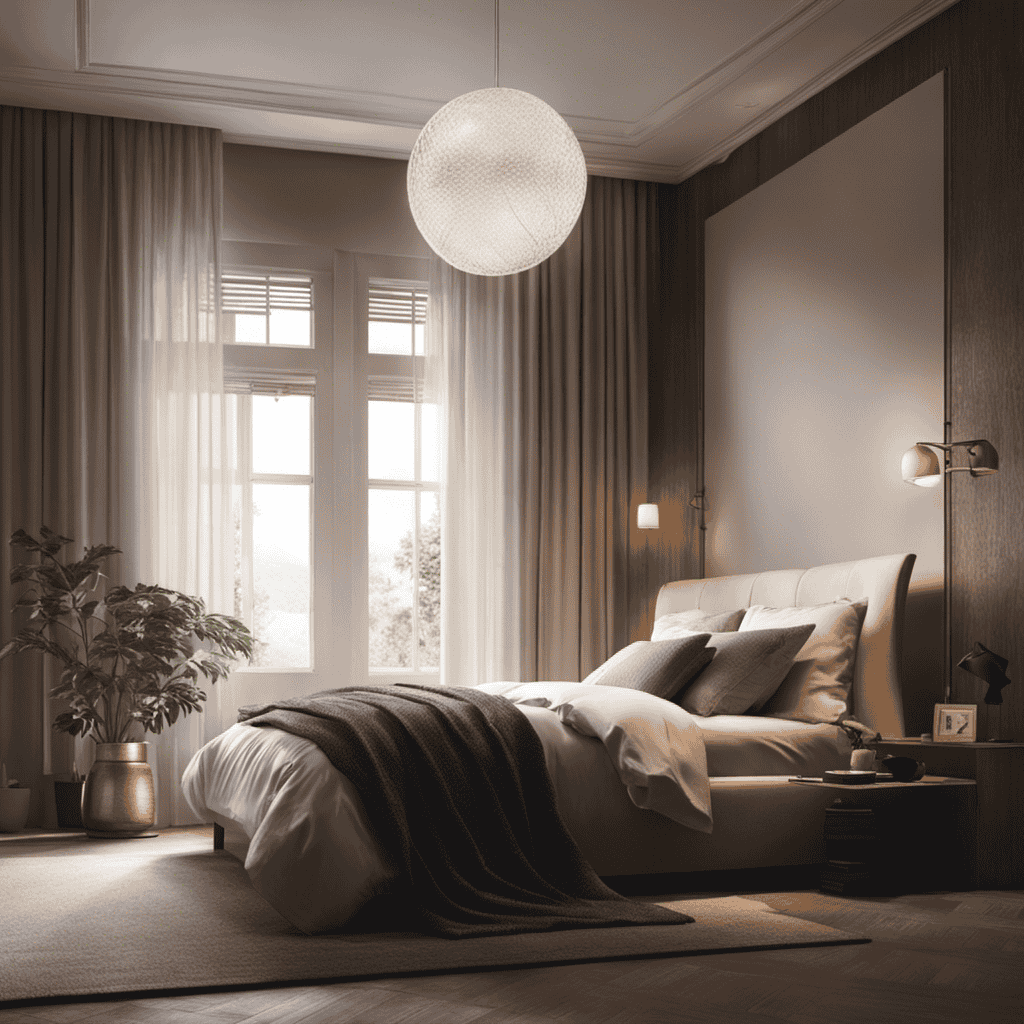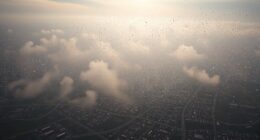During wildfire smoke alerts, immediately switch your air purifier to high or run it continuously to maximize filtration. Make sure your HEPA filters are clean and effective, and keep doors and windows sealed to prevent smoky air from entering. Use real-time air quality data to adjust settings and consider sealing gaps with weather stripping or towels. For more essential tweaks to improve your indoor air quality, explore the full guide.
Key Takeaways
- Switch your air purifier to high or continuous mode to maximize filtration during smoke events.
- Ensure HEPA filters are clean and replace them promptly for optimal particle removal.
- Seal all indoor openings with weather stripping or damp towels to prevent smoke infiltration.
- Position purifiers in high-occupancy or high-risk rooms for targeted air cleaning.
- Monitor indoor air quality data regularly and adjust purifier settings accordingly.
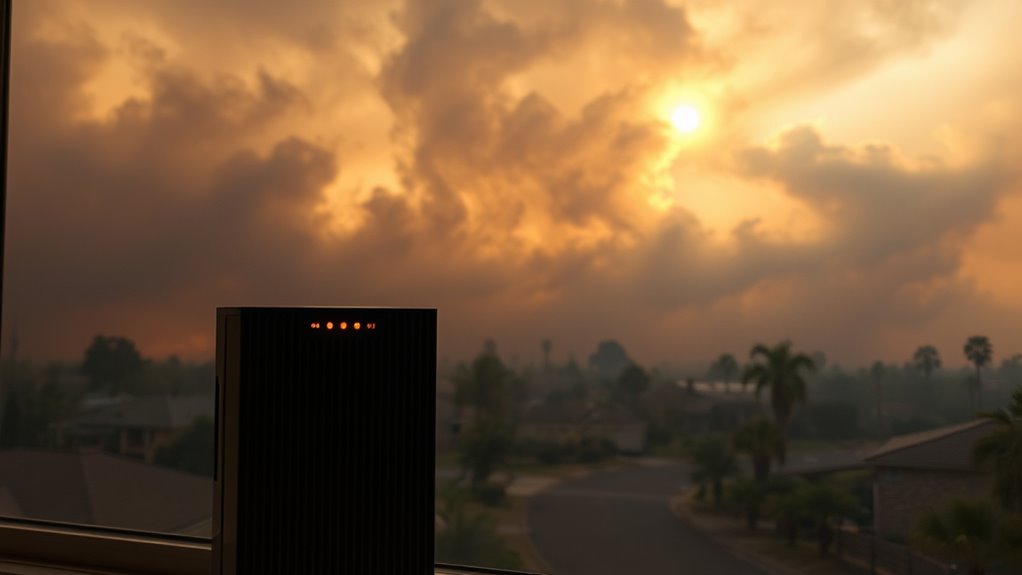
Are you prepared for the dangers of wildfire smoke? When wildfires rage nearby, smoke can quickly infiltrate your home, posing serious health risks. Staying ahead means understanding how to improve indoor air quality and protect your respiratory health. One of the most effective steps you can take is leveraging air quality monitoring. By using a good-quality air purifier equipped with sensors, you can track the levels of particulate matter like PM2.5 inside your home. This real-time data helps you determine when to increase filtration or take additional precautions. If the air quality drops, it’s time to act fast. Adjust your purifier’s settings to high, or run it continuously to keep that smoky air at bay. Remember, the key is maintaining a safe indoor environment, especially when outdoor air becomes increasingly hazardous.
In addition to monitoring, adopting specific respiratory health tips can make a vital difference. First, keep your windows and doors tightly sealed to prevent smoky air from sneaking inside. Covering any gaps with weather stripping or damp towels can help block infiltration. Wearing N95 masks when you need to go outside provides extra protection, filtering out harmful particles before they reach your lungs. Inside, consider using a humidifier; maintaining a humidity level of around 40-60% helps prevent the dry, irritated feeling often caused by smoky air and makes filtration more effective. Staying hydrated is equally important, as water helps thin mucus in your respiratory system, making it easier to clear out irritants. Proper maintenance of your air purifier and filters is crucial during wildfire events to ensure optimal performance and air quality. If you experience symptoms like coughing, shortness of breath, or throat irritation, don’t ignore them—seek medical advice promptly.
Another vital aspect is regularly checking your air quality monitoring devices. These tools can alert you when pollutant levels spike, prompting you to take additional measures like relocating to a different room or using an air purifier with HEPA filters. Remember, wildfire smoke contains fine particles that can penetrate your lungs and even enter your bloodstream, leading to long-term health issues. Protecting yourself means being proactive—adjusting your indoor environment and following respiratory health tips consistently during wildfire events. Keep yourself informed with local air quality reports, and don’t wait until symptoms worsen to act. By combining diligent air quality monitoring with targeted purifier adjustments and health precautions, you can greatly reduce your exposure and safeguard your respiratory health until the wildfire threat subsides.
Frequently Asked Questions
How Often Should I Replace My Air Purifier Filters During Wildfire Season?
During wildfire season, you should replace your air purifier filters more frequently than usual. Typically, filter lifespan varies with usage, but during heavy smoke, it’s best to check and substitute filters every 1 to 2 months. Increase maintenance frequency to ensure your purifier effectively removes harmful particles. Regularly inspect your filters for dirt buildup, and don’t wait too long—prompt replacements keep your air clean and safe.
Can Outdoor Air Purifiers Effectively Reduce Indoor Smoke Levels?
Outdoor air purifiers can help reduce indoor smoke levels, but their smoke reduction effectiveness varies. They draw in outdoor air and filter out particles, which can improve air quality during wildfire season. However, for ideal results, you should use a purifier designed for outdoor use, guarantee proper placement, and keep windows closed. Remember, indoor air purifiers generally offer better smoke reduction, but outdoor purifiers can still provide some relief in challenging conditions.
Are There Specific Air Purifier Models Recommended for Wildfire Smoke?
Think of choosing an air purifier like picking a knight for a battle—sharp, strong, and ready. For wildfire smoke, look for models from trusted air purifier brands that feature advanced smoke filtration technologies like HEPA filters and activated carbon. These help trap tiny particles and harmful gases. Brands like Coway, Blueair, and Winix often lead the charge, providing reliable protection when wildfire smoke clouds your surroundings.
How Do I Know if My Purifier Is Handling Smoke Effectively?
To know if your purifier handles smoke effectively, check its filter performance and smoke detection features. Look for indicators like increased airflow or filter change alerts, which show it’s working hard. You can also monitor air quality with a meter; if levels drop after turning on your purifier, it’s doing its job. Regularly clean or replace filters to maintain peak smoke removal, especially during wildfire events.
What Additional Steps Can I Take Alongside Using an Air Purifier?
Boost your barrier against smoke by blending better ventilation strategies with indoor plant benefits. Besides running your purifier, open windows when outdoor air quality improves, and use exhaust fans to vent smoky air outside. Incorporate indoor plants like spider plants or peace lilies to naturally filter toxins. These steps synergize to strengthen your space’s safety, making your environment healthier and helping you breathe easier during smoky seasons.
Conclusion
Now that you’ve made these quick purifier tweaks, you’re like a fortress standing strong against wildfire smoke. Think of your home as an oasis of clarity amid a hazy battlefield, where each adjustment clears the air and shields your breath. With these simple changes, you’re not just surviving the smoke—you’re turning your space into a sanctuary. Stay vigilant, breathe easy, and let your purifier be the lighthouse guiding you safely through the smoky storm.
